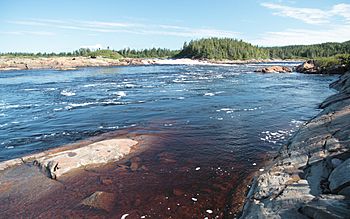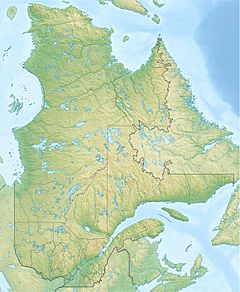Aguanish River facts for kids
Quick facts for kids Aguanish River |
|
|---|---|

Looking north up the river from Quebec Route 138
|
|
| Other name(s) | Rivière Aguanish |
| Country | Canada |
| Province | Quebec |
| Region | Côte-Nord |
| RCM | Minganie |
| Physical characteristics | |
| River mouth | Gulf of Saint Lawrence 0 metres (0 ft) 50°13′05″N 62°05′10″W / 50.2180556°N 62.0861111°W |
| Length | 280 kilometres (170 mi) |
| Basin features | |
| Basin size | 5,777 square kilometres (2,231 sq mi) |
The Aguanish River (called Rivière Aguanish in French) is a beautiful river in the Côte-Nord region of Quebec, Canada. It's famous for its salmon! The river flows from north to south and eventually empties into the huge Gulf of Saint Lawrence.
Contents
Where is the Aguanish River?
The Aguanish River is super long, stretching over 280 kilometres (170 mi)! It has a cool spot called the Trait-de-Scie, which means "Sawtooth." This is a narrow canyon, only about 8 metres (26 ft) wide. It has many rapids and small waterfalls. Salmon bravely swim through here to go upstream.
The river's strong current has carved out big, round holes in the pink granite riverbed. People call these "giant cooking pots."
The river's mouth, where it meets the sea, is just southwest of the village of Aguanish. This village is part of the Minganie Regional County Municipality. The river mouth is also about 25 kilometres (16 mi) west of Natashquan.
You can easily see the first waterfalls right in the middle of the village. They are just north of the Quebec Route 138 bridge. There's a path from a parking lot west of the bridge that leads right to them.
What's in a Name?
The name "Aguanish River" became official on April 11, 1985. But it has been known by many names over the years! Some old maps called it Goynish River or Aguanus River. You might also see spellings like Goines, Guanis, Goinis, Agwanus, or Agouanus.
The name likely comes from the Innu language. One idea is that akwanich means "small shelter." Another old book from 1914 suggests that Agwanus or Agouanus means "where one unloads" boats. Some people also think it means "poor place" or "place with little." A different idea is that it comes from the Innu word akuannis, which describes a beaver scooping mud to build its home.
River Description
An old book from 1914, called the Dictionnaire des rivières et lacs de la province de Québec, described the Aguanish River. It said the river forms the eastern border of the Mingan area. The book also mentioned that the English called it the Goynosh River. It was known as an excellent river for catching trout.
At that time, a village was located on both sides of the river. The land nearby was thought to be good for farming. Even back then, ships that needed about eight feet of water could easily enter the river.
The River's Basin
The Aguanish River's basin, which is the area of land that drains into the river, covers a huge 5,777 square kilometres (2,231 sq mi). It sits between two other river basins: the Nabisipi River to the west and the Natashquan River to the east.
Most of the basin is in a wild, unorganized area called Lac-Jérôme. A smaller part is within the municipality of Aguanish.
Fish in the Aguanish River
The Aguanish River is home to several types of fish. You can find:
- Brook trout (Salvelinus fontinalis)
- Landlocked Atlantic salmon (Salmo salar)
- Northern pike (Esox lucius)
Sport fishing has been allowed on the river since 1988. The local Innu people of Natashquan have special rights to fish in a 4 kilometres (2.5 mi) part of the river. This section goes from the river's mouth up to the Trait-de-Scie canyon.
There are several great spots for salmon fishing, called salmon pools. Six of these pools are below the first waterfalls, and three are above the second waterfalls. Most of the salmon caught here weigh between 3.6–5.4 kilograms (7.9–11.9 lb).
In 2015, the Quebec government started a special program for sport fishing on some salmon rivers, including the Aguanish. For large salmon, anglers had to catch and then release them back into the river. This was done to help protect the salmon population, which was getting smaller. Many people felt that even more should be done to protect these amazing fish for the future.


